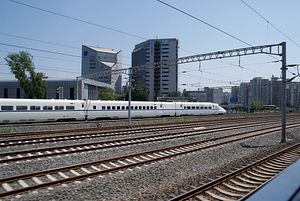To meet the challenge of climate change, there is a need to massively increase financing for sustainable infrastructure: the governor of the Bank of England, Mark Carney, recently estimated that to enable a transition to a low carbon economy there is a need for a four-fold increase in finance in new technology investments and long-term infrastructure projects.
China, through its Belt and Road Initiative, could help provide this financing. Given its scale and ambition – China has already pledged $1 trillion to Belt and Road projects – this initiative could have a transformative impact.
Sustainable infrastructure is that which not only minimizes any negative environmental and social impacts but also brings about positive change, enhancing the environment, livelihoods, and the economy. Therefore, investing in such projects has a crucial role to play in helping countries to shift toward low-carbon development pathways.
Doing so would not only help achieve China’s objective for the Belt and Road of promoting sustainable development, but it would also provide an opportunity for China to become a global leader in sustainable infrastructure. However, achieving this will require a change in approach by both China’s government and its investors.
At the moment, there is widespread recognition within China’s finance community of the implications of environmental and social issues for financial risk. For example, existing bank policies and guidelines on green finance highlight the need for overseas projects to comply with national legislation and recommend that they meet international best practice on environmental and social safeguards. In addition, for a number of sectors – forestry, rubber, and mining – guidelines have been developed to help companies improve their management of environmental and social risks.
While positive, the aim of these policies is primarily limited to the reduction of any negative impacts directly associated with an investment. Thus, China’s role has been to provide finance and services in response to demand from partner countries, rather than seeking to influence what is being requested. Furthermore, little consideration has been given by Chinese banks as to whether their entire investment portfolio is in line with the climate change agenda or Sustainable Development Goals. Thus, while they have massively increased the provision of green finance, they have also continued to invest in highly-polluting sectors, such as coal.
If China is serious about its goal to promote sustainable development, a more rigorous and consistent approach is needed. What this means for the Belt and Road Initiative is that China should be working with partner governments to increase the demand for sustainable infrastructure, and ensuring that its investments drive best practice and promote innovation. One policy tool that could be used to help achieve this is sustainable procurement, as is explained in a recent report from Chatham House.
This would be a new approach in China. While sustainable procurement is a well-known concept in the country, its use has been limited to managing supply chains rather than entire assets. It would also arguably represent a new approach in that it would entail China seeking to influence the procurement policy of a foreign government. However, encouraging the use of sustainable procurement should be seen as a means of cooperation, of mutual benefit to China and its partners. As such, this approach is in line with China’s principles for overseas engagement and also with the goal of the Belt and Road to improve policy coordination and to promote “ecological progress in conducting investment and trade.”
This is in fact the approach of the multilateral development banks (MDBs): they seek to encourage the use of sustainable procurement rather than requiring this of their government borrowers. This is in recognition that implementing sustainable procurement requires a relatively high level of capacity, both within government and the private sector, and so different approaches and different degrees of ambition for sustainability will be appropriate in different countries.
Thus, the approach of the MDBs has been to make it explicit in their own policies that government borrowers can consider sustainability criteria when assessing the “value for money” of projects. Further, they have worked with governments to identify capacity-building needs to facilitate the use of this approach and provided financing for this. So although there is no requirement to use this policy tool, increasingly its use is being actively encouraged as a means to support countries in finding innovative and sustainable infrastructure solutions. Such an approach could readily be adopted by China’s policy banks when providing finance to other governments.
The Belt and Road could thus enable realization of the prediction that sustainable infrastructure is “the growth story of the future.” This represents a huge opportunity for China’s private sector given its capabilities in infrastructure. However, to make the most of this opportunity, China will need to strengthen the expertise of its private sector in designing, building, and operating sustainable infrastructure.
There are a number of ways through which this could be achieved. On the part of China’s banks, they should further encourage the use of sustainable procurement by private sector borrowers. For example, they could require its use as part of environmental and social safeguard policies, or incentivize this through offering cheaper credit to companies with such policies in place as part of the green finance policy framework. On the part of government, it should require companies to meet sustainability criteria as part of the approval process for operating overseas, and in support of this, official guidance for companies on sustainable infrastructure should be developed.
Through working with partner countries and prioritizing the development of its private sector, China could help to transform the infrastructure sector. In doing so, China would make a vital contribution towards addressing climate change and placing the world on a more sustainable pathway.
Alison Hoare is Senior Research Fellow in Chatham House’s Energy, Environment and Resources department.

































